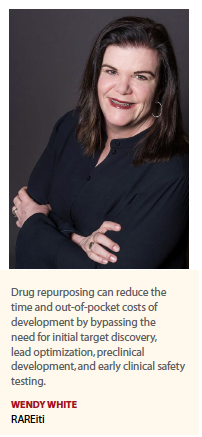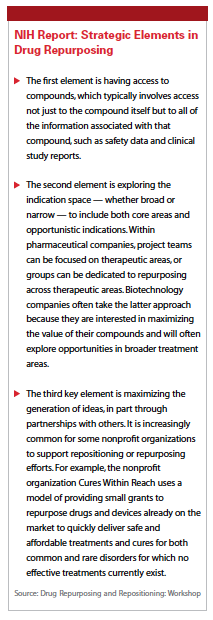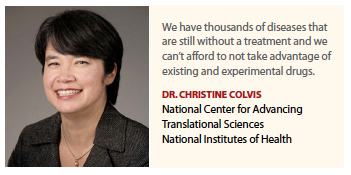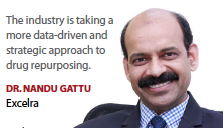The industry is becoming more strategic about repurposing its existing and shelved drugs.
In the 1960s it became apparent that the drug thalidomide caused horrible birth defects in babies when pregnant mothers took it to treat their nausea. It was removed from the market. However today, that same drug is being used to treat a number of cancers, including multiple myeloma.
Viagra (sildenafil) failed in clinical studies as a treatment for hypertension, but in 2012 was repositioned and became one of the most successful treatments for erectile dysfunction, still earning the majority share of the market decades after launch, and even after patent expiry. The controversial abortion pill Korlym is being used to treat Cushing’s syndrome, a rare and potentially deadly condition that causes high levels of the hormone cortisol.
There are plenty more examples of drugs being used in applications other than originally planned. Eflornithine was initially developed to treat cancer but was later found to be effective against African Trypanosomiasis (sleeping sickness) and against growth of unwanted facial hair (i.e., Vaniqa cream for women). Rituximab, primarily developed to treat blood cancers, was repositioned as a blockbuster drug for rheumatoid arthritis and other autoimmune disorders.
And amantadine, intended to treat influenza, is now used solely to treat Parkinson’s disease. Tikosyn (dofetilide) has been available since 1999 to help treat patients with irregular heartbeats. Recently, scientists at Georgetown University have found a potential new use for it, treating pulmonary arterial hypertension, years after the drug has gone generic.
Botox is yet another good example of a drug developed for one indication but ending up being more  successful for a different indication. Effective in stopping muscle activity in a controlled and focused way, it was initially developed as a treatment for crossed eyes and uncontrollable blinking, but became widely used for cosmetic applications. Today, it is being tested across many diseases where reducing muscle activity improves outcomes, including Parkinson’s disease, ALS, and overactive bladder.
successful for a different indication. Effective in stopping muscle activity in a controlled and focused way, it was initially developed as a treatment for crossed eyes and uncontrollable blinking, but became widely used for cosmetic applications. Today, it is being tested across many diseases where reducing muscle activity improves outcomes, including Parkinson’s disease, ALS, and overactive bladder.
These examples — and there are many more — demonstrate how the industry for years has been repurposing therapeutics into successful treatments for other conditions, including several rare diseases and hard to treat cancers.
However, with today’s advances in technology and data analysis, drug repurposing has evolved into a go-to strategy for some companies to build their pipelines and get as much value as possible out of their time and money investments in R&D.
According to a recent Forbes report written by infectious disease specialist Dr. Judy Stone, there are about 2,000 shelved drugs in the industry, including 1,500 FDA-approved drugs that were shelved because they were deemed not profitable enough. These drugs represent a ripe opportunity for companies that are eager to pursue their possibility for other indications. Developing a drug from this approach is much less costly and more time efficient. Dr. Stone says through repurposing a company could potentially develop a drug in 18 months to 36 months and for less than $250,000.
According to Market World reports, Astellas, Biovista, Novartis, AbbVie, Pfizer, Allergan, and NuMedii are all engaged in the practice of repurposing.
And pharma companies are not the only players in the repurposing landscape. Patient organizations, consultants, and academia are all taking steps forward to use this strategy, sometimes called rediscovery research, to find treatments from existing drugs to fill other unmet medical needs.
For example, Cures Within Reach, a nonprofit organization that works to facilitate clinical trials to test repurposed drugs as treatments for rare diseases, has funded more than 76 projects and reports that four out of 10 of its repurposed drug projects have had a direct impact on improving patients’ lives, a much higher success rate than the 10% rate for novel drugs in development.
Rare disease organizations have a vested interest in repurposing due to the large unmet need in the field; currently, more than 70% of rare disease patients receive off-label therapies. Researching the thousands of shelved or failed drugs looking for a new indication in rare disease is gaining traction in this space.
“Some products may have been screened for a use and seen as unlikely to succeed, yet 10 years later with different and more sophisticated screening approaches different features of the asset may come to light, such as the impact on new molecular pathways that were unknown previously," says Wendy White, co-founder, RareiTi. “First-generation thalidomide to third-generation pomalinamide is a good example."
At the National Center for Advancing Translational Sciences, (NCATS) National Institutes of Health, there is a Discovering New Therapeutic Uses for Existing Molecules program, which supports preclinical and clinical research using experimental drugs provided by pharmaceutical company partners for indications not being pursued by the companies.
NCATS designed this program to align with one of its primary goals: to foster approaches that improve the translational research pipeline and ultimately accelerate the pace at which discoveries are turned into new preventions, treatments and cures for human diseases.
NCATS has a three-way partnership with pharmaceutical companies and the biomedical research community to advance therapeutics development. The focus is on matching researchers with a selection of pharmaceutical assets to help the scientists test ideas for new therapeutic uses.
Through this initiative, NCATS is re-engineering the research pipeline, using innovative strategies to identify new uses for existing therapies that have undergone significant research and development by industry, including safety testing in humans. Coordinating the access that scientists nationwide have to existing therapies that have already cleared several key steps in the development process can accelerate the pace of development.
The director of that unit, Christine Colvis, Ph.D., says this is a sound strategy that could yield positive outcomes.
“The concept of repurposing is not a new one, but what is a bit different now is the academic sector taking a more active role," Dr. Colvis says. “Being able to leverage the investment in the development of a drug that has been made by a pharmaceutical company positions the academic researcher squarely in a translational space where they can apply their knowledge of molecular pathophysiology through a clinical trial. This potential to see basic research lead to disease treatment in one’s lifetime has historically been out of reach."
A repurposing enthusiast, Dr. Colvis says the advantages of repurposing far outweigh the downsides.
“If an experimental drug has not made it to the market yet, and it failed to treat the condition for which it was originally being developed, it only makes sense to explore other conditions since a significant investment already has been made," she says.
There are clear benefits to having access to available products to study for different purposes, including the reduced costs and trial burden to launch the new indication, rather than the massive upside as researchers look for a new chemical entity blockbuster, Ms. White says. This makes the approach attractive in areas that have more limited resources to invest, such as rare diseases.
“Drug repurposing can reduce the time and out-of-pocket costs of development by bypassing the need for initial target discovery, lead optimization, preclinical development, and early clinical safety testing," she says. “Around the world many medications are provided to patients through compassionate use or managed access programs that can both provide real-world evidence around how therapies work and point the way for indications and geographies where repurposing makes sense."
Serendipity vs. Strategy
Some of the most well-known drug repurposing cases occurred by chance — discovered during the process of finding a different treatment in clinical trials for another disease or indication.
Thalidomide and sildenafil are two examples of such observations. But serendipity is not a strategy to rely on, and with the advances in data analytics and computational technology, there are better ways to discover new roles for old drugs.
“Pharma is taking a more of a data-driven and strategic approach to drug repurposing," says Nandu Gattu, Ph.D., senior VP, pharma analytics and drug repurposing at Excelra, a data and analytics company.
“Instead of waiting for serendipity-driven drug repurposing, companies are evaluating the alternative indications of the drug considering the drug target, what pathways the particular drug is up-regulating and down-regulating; understanding what similar drugs are available; and examining current clinical trials that are being conducted."
A strategy should include a review of the entire pharmacology, biology, toxicology, clinical trial information, genetics, genomics, and chemistry of that drug in a 360-degree manner, he says. Bringing all of this evidence together creates a faster, smoother pathway to finding the science to a new indication.
“We put together the information layer by layer, so at the end of the day, we have a very good scientific justification to make a recommendation," Dr. Gattu says.
Excelra recently signed on with Japanese pharmaceutical company Maruho to help the drug maker  discover and develop novel therapeutic hypotheses in dermatology, and with Keio University School of Medicine in Japan to explore new therapeutics for a rare indication.
discover and develop novel therapeutic hypotheses in dermatology, and with Keio University School of Medicine in Japan to explore new therapeutics for a rare indication.
Excelra has a database of about 9 million structure-activity relationship compounds collected over the last 18 years from scientific publications and journals. “It is very useful for us to understand the similar compounds and extrapolate the information," Dr. Gattu says. “But there are two things necessary for all this analysis to be successful: algorithm and data."
Drivers of Repurposing
The combination of drying pipelines, cost and technological advancement, along with a realization that there are many drugs sitting on the sidelines that were abandoned for business reasons are driving a new push toward repurposing, Ms. White says.
According to the International Journal of Biological Sciences, drug repositioning has become a popular strategy in recent years. Different from traditional drug development strategies, repurposing is efficient, economical, and mostly riskless. There are usually three types of approaches widely used in drug repositioning: computational approaches, biological experimental approaches, and a mix of the two.
“Machine learning and AI-enabled approaches to understanding genetics and molecular pathways of disease etiology have massively enhanced our understanding of the complexity of conditions," Ms. White adds. “Consequently, the number of potential approaches to treating conditions has increased. This means there are many more potential drug targets to evaluate to treat a variety of conditions."
The National Center for Advancing Translational Sciences at the National Institutes of Health supports repurposing projects that use ML or AI strategies to develop their hypothesis to determine which computational tools are most effective at accurately predicting which drug will work for a given condition. Dr. Colvis says, however, the agency is cautious about relying too heavily on ML and AI until it can prove itself as valuable to the process.
“I don’t know that machine learning and artificial intelligence are driving repurposing strategies so much as they are running in parallel," she says. “The reality is that ML and AI in medicine are still in their infancy and we have yet to see a robust system for drug repurposing."
However, Dr. Colvis believes that in the near future there will be AI systems that transform the way in which researchers develop hypotheses by changing the way in which data and knowledge are mined.
Dr. Gattu attributes the accessibility and the availability of more clinical trial data as a plus for driving a repurposing strategy. Companies no longer have to rely on their own proprietary data. There are myriad public data banks that researchers now have access to, and the computational tools in today’s market provide a way to parse through big data more easily.
“There is a ton of a genomic and genetic-oriented data available in the public arena that we use on a regular basis," Dr. Gattu says. “At the same time, there are quite a number of people opening up their clinical trial data, so this information is also being used."
Data-driven approaches also include literature mining, which is now possible through text mining and NLP capabilities. This enables mining unstructured articles and receiving output in a structured manner. “This makes it easy to understand what’s going on, so we can connect A to B and B to C," Dr. Gattu says. “There is always an opportunity for us to link between a drug and new diseases using this data-driven approach."
Potential Challenges and Naysayers
Not everyone is of the opinion that computational drug repurposing is the next best thing since sliced bread. Some critics believe that while it shows promise, there is still a lot of hype, and many state they prefer the old-fashioned way: clinical development through all the stages. Some detractors feel that the approach itself has a shelf life; there are only so many drugs to be tested against other diseases.
University of Cambridge Judge Business School has found that only 2% of new molecules entering clinical trials were ultimately launched in an area other than for which they were initially tested. The study states that attempting to repurpose some drugs can be a good approach given the rising costs of new drug development, but the data shows a low overall success rate for repurposing, particularly in producing successes in a new disease setting.
The report says, “as promising as repurposing might be, basic research remains essential. It will not only help us understand where failed drugs might have a second chance, but, more importantly, will also continue to create a fertile environment for the often-unexpected discoveries that can launch entirely new classes of medicine."
However, it does conclude that it can be successful in some cases, stating that for products resulting from large amounts of time and resources in research, development, testing, and manufacturing, “there can be good reasons to consider the possibility of repurposing, even after an initial clinical failure."
“The skepticism of repurposing comes from either an over-confidence in the originator company’s R&D, meaning that it would have tried all the potential product indications and is throwing good money after bad or an under-confidence in the scientific/clinical justification for the repurposing of a specific asset in a new indication and it’s unlikelihood to succeed," Ms. White says. “The risk of repeating a previous failure is harder to take with limited resources rather than speculating on new innovation."
A summary report on a workshop funded by the NIH on drug repurposing and repositioning outlines several potential barriers. Companies are typically focused on certain disease areas, so they sometimes miss opportunities to follow the biology of a compound into different areas. Repositioning can also be a distraction to organizations that are focused on specific disease areas.
A discontinued compound does not have a project team, and an active project team typically is dedicated to getting a drug to work on its current indication rather than exploring different  indications. Furthermore, individuals in a company may view drug repositioning as less innovative than developing an entirely new drug.
indications. Furthermore, individuals in a company may view drug repositioning as less innovative than developing an entirely new drug.
Another challenge is the restriction of the number of compounds with which to work, and limited capital to invest in projects. Other reasons that a repurposing project might not proceed include a company not having an appropriate compound, a project having a low probability of success, reimbursement by payers posing challenges, the market being too small, or regulatory approval endpoints having not been defined, says the report.
Repositioning can also raise complex issues about regulatory filings, pricing, and other considerations, all of which can serve as deterrents to project teams.
For example, in collaborations an investigator will often request updated clinical regulatory documents, such as an investigational new drug application, and it can be time-consuming to collect all of the updated information and make the changes to the existing document.
A clinical study may have closed before all the data were in, or a new set of pharmacokinetic data or chemistry, manufacturing, and control sections may need to be generated. Safety reporting and pharmacovigilence also can be complicated for such projects.
Additionally, investigator-initiated studies or out-licensing may require a support infrastructure and legal agreements.
Patent exclusivity or remaining patent life can be another major consideration, as can data exclusivity, which is another way of obtaining market exclusivity.
“If a drug has been on the market long enough that it is available as a generic, any investment made to test the drug for other conditions is very difficult to recoup, unless the drug is reformulated," Dr. Colvis says. “This is true even though there may be a use patent for the new condition because there is no practical way to enforce the patent."
The Future
“Drug repurposing activity will continue to grow," Dr. Colvis says. “We have thousands of diseases that are still without a treatment and we can’t afford to not take advantage of existing drugs and experimental drugs to see if they might work for those diseases. As we learn more about biology and pathophysiology, we will see new connections between the diseases and existing therapies."
According to Dr. Gattu, repurposing will always be an opportunity for pharma companies for multiple reasons: drying pipelines, lack of new molecular entities being discovered, new technologies, and more data that provide the setting for repurposing.
 “New technologies are evolving, but at the same time, pipelines are not improving for individual pharma companies," he says. “So, in my opinion, drug repurposing is going to be used even after a drug is on the market for 10 years because the more real-world evidence that is available will help clarify the picture."
“New technologies are evolving, but at the same time, pipelines are not improving for individual pharma companies," he says. “So, in my opinion, drug repurposing is going to be used even after a drug is on the market for 10 years because the more real-world evidence that is available will help clarify the picture."
Ms. White agrees, adding that the approach will continue due to a number of key drivers, such as intelligence (data), focus on key therapeutic areas, return on investment, etc. “Time will tell how relevant and valuable this new market sector will be," she adds.
As more and more conditions are identified and categorized, companies are looking for treatments and cures. Resource efficient approaches to screening established products that have been overlooked — or not assessed for the new condition — are enduring features driving the trend. This is more pertinent in resource limited areas such as individual rare diseases.
The trend may also progress to reassessing and repurposing assets where development stopped in Phase III for one indication, but the mechanism of action may lead to efficacy in newer categorized conditions.
“My perspective is that there is plenty of opportunity right now to consider what is on the market, how these drugs are being used across the globe, and which ones could benefit patients and payers the most; I think this could keep us busy for a couple of generations," Ms. White says.(PV)
~~~~~~~~~~~~~~~~~~~~~~~~~
NIH Report: Strategic Elements in Drug Repurposing
The first element is having access to compounds, which typically involves access not just to the compound itself but to all of the information associated with that compound, such as safety data and clinical study reports.
The second element is exploring the indication space — whether broad or narrow — to include both core areas and opportunistic indications. Within pharmaceutical companies, project teams can be focused on therapeutic areas, or groups can be dedicated to repurposing across therapeutic areas. Biotechnology companies often take the latter approach because they are interested in maximizing the value of their compounds and will often explore opportunities in broader treatment areas.
The third key element is maximizing the generation of ideas, in part through partnerships with others. It is increasingly common for some nonprofit organizations to support repositioning or repurposing efforts. For example, the nonprofit organization Cures Within Reach uses a model of providing small grants to repurpose drugs and devices already on the market to quickly deliver safe and affordable treatments and cures for both common and rare disorders for which no effective treatments currently exist.
Source: Drug Repurposing and Repositioning: Workshop Summary, NIH



















